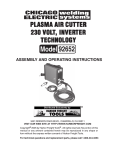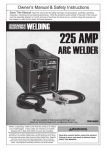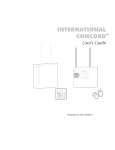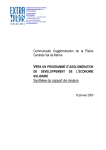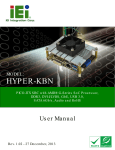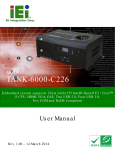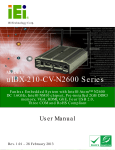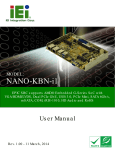Download Harbor Freight Tools 91146 User's Manual
Transcript
MIG WELDER - 250 AMP Model 91146 ASSEMBLY AND OPERATING INSTRUCTIONS ® 3491 Mission Oaks Blvd., Camarillo, CA 93011 Visit our Web site at: http://www.harborfreight.com Copyright© 2005 by Harbor Freight Tools®. All rights reserved. No portion of this manual or any artwork contained herein may be reproduced in any shape or form without the express written consent of Harbor Freight Tools. For technical questions, please call 1-800-444-3353. PRODUCT SPECIFICATIONS Item Electrical Requirements Duty Cycles Maximum Welding Thickness Capacity Welding Current Required Wire Sizes Wire Control Settings Gun Coolant Type Fuse Type Gun Power Cable Length Ground Clamp Cable Length Wheels Accessories Weight Description Input Voltage: 220V / 60 Hz / 45 Input Amperage Power Cord: 10 AWG @ 6’ Long Power Plug: 220V (not included), Requires 50 Amp Circuit 60% @ 250 Amps / 100% @ 195 Amps Up To 3/8” Mild Steel 30 – 250 Amps .024” To .047” Diameter Internal, Spot & Pause, 4 Time, & 2 Time Air Cooled 3 AMP Buss Fuse 13’ 13’ Front: Swivel Castors / 3-1/4” Diameter x 1” Thick Rear: Rigid / 8” Diameter x 1-1/2” Thick on 7/8” Diameter Axle Gas Pressure Regulator w/Flow Meter Welding Gloves / Face Mask / 1 Torch Liner / 5 Spare Tips 187 Pounds SAVE THIS MANUAL You will need this manual for the safety warnings and precautions, assembly, operating, inspection, maintenance and cleaning procedures, parts list and assembly diagram. Keep your invoice with this manual. Write the invoice number on the inside of the front cover. Keep this manual and invoice in a safe and dry place for future reference. UNPACKING When unpacking, check to make sure all the parts shown on the Parts Lists on pages 26 and 27 are included. If any parts are missing or broken, please call Harbor Freight Tools at the number shown on the cover of this manual as soon as possible. GENERAL SAFETY RULES WARNING! READ AND UNDERSTAND ALL INSTRUCTIONS Failure to follow all instructions listed below may result in electric shock, fire, and/or serious injury. SAVE THESE INSTRUCTIONS WORK AREA 1. Keep your work area clean and well lit. Cluttered benches and dark areas invite accidents. 2. Do not operate welding equipment in explosive atmospheres, such as in the presence of flammable liquids, gases, or dust. Welding equipment creates sparks which may ignite the dust or fumes. SKU 91146 For technical questions, please call 1-800-444-3353. PAGE 2 3. Keep bystanders, children, and visitors away while operating welding equipment. Distractions can cause you to lose control. Protect others in the work area from arc rays, sparks, and slag. Provide barriers or shields as needed. ELECTRICAL SAFETY 1. Grounded welding equipment must be plugged into an outlet properly installed and grounded in accordance with all codes and ordinances. Never remove the grounding prong or modify the plug in any way. Do not use any adapter plugs. Check with a qualified electrician if you are in doubt as to whether the outlet is properly grounded. If the welding equipment should electrically malfunction or break down, grounding provides a low resistance path to carry electricity away from the user. 2. Avoid body contact with grounded surfaces such as pipes, radiators, ranges, and refrigerators. There is an increased risk of electric shock if your body is grounded. 3. Do not expose welding equipment to rain or wet conditions. Water entering welding equipment will increase the risk of electric shock. 4. Do not abuse the Power Cord. Never use the Power Cord to carry welding equipment or pull the Plug from an outlet. Keep the Power Cord away from heat, oil, sharp edges, or moving parts. Replace damaged Power Cords immediately. Damaged Power Cords increase the risk of electric shock. 5. When operating welding equipment outside, use an outdoor extension cord marked “W-A” or “W”. These extension cords are rated for outdoor use, and reduce the risk of electric shock. The minimum extension cord size for this tool is 6 GAUGE for cords UP TO 25’ LONG. CORDS LONGER THAN 25’ SHOULD NOT BE USED WITH THE WELDER. PERSONAL SAFETY 1. Stay alert. Watch what you are doing, and use common sense when operating welding equipment. Do not use welding equipment while tired or under the influence of drugs, alcohol, or medication. A moment of inattention while operating welding equipment may result in serious personal injury. SKU 91146 For technical questions, please call 1-800-444-3353. PAGE 3 2. Dress properly. Do not wear loose clothing or jewelry. Contain long hair. Keep your hair, clothing, and gloves away from hot or moving parts. Loose clothes, jewelry, or long hair can be caught in hot or moving parts. (See page 8, number 3, for recommended safety clothing.) 3. Avoid accidental starting. Be sure the Power Switch is off before plugging in. Plugging in welding equipment with the Power Switch on invites accidents. 4. Remove adjusting keys or wrenches before turning on the welding equipment. A wrench or a key that is left attached to an electrically charged part of the welding equipment may result in personal injury. 5. Do not overreach. Keep proper footing and balance at all times. Proper footing and balance enables better control of the welding equipment in unexpected situations. TOOL USE AND CARE 1. Use clamps (not included) or other practical ways to secure and support the workpiece to a stable platform. Holding the work by hand or against your body is unstable and may lead to loss of control. 2. Do not force the welding equipment. Use the correct equipment for your application. The correct equipment will do the job better and safer at the rate for which it is designed. 3. Do not use the power tool if the Power Switch does not turn it on or off. Any equipment that cannot be controlled with the Power Switch is dangerous and must be replaced. 4. Disconnect the Power Cord Plug from the power source before making any adjustments, changing accessories, or storing the welding equipment. Such preventive safety measures reduce the risk of starting the welding equipment accidentally. 5. Store idle welding equipment out of reach of children and other untrained persons. Welding equipment is dangerous in the hands of untrained users. 6. Maintain welding equipment with care. Keep equipment clean and dry. Properly maintained equipment is less likely to malfunction and is easier to control. Do not use damaged welding equipment. Tag damaged equipment “Do not use” until repaired. 7. Check for misalignment or binding of moving parts, breakage of parts, and any other condition that may affect the equipment’s operation. If damaged, have the equipment serviced before using. Many accidents are caused by poorly maintained equipment. SKU 91146 For technical questions, please call 1-800-444-3353. PAGE 4 8. Use only accessories that are recommended by the manufacturer for your model. Accessories that may be suitable for one type of welding equipment may become hazardous when used on another type of equipment SERVICE 1. Equipment service must be performed only by qualified repair personnel. Service or maintenance performed by unqualified personnel could result in a risk of injury. 2. When servicing welding equipment, use only identical replacement parts. Follow instructions in the “Inspection, Maintenance, And Cleaning” section of this manual. Use of unauthorized parts or failure to follow maintenance instructions may create a risk of electric shock, burns, or other injury. SKU 91146 For technical questions, please call 1-800-444-3353. PAGE 5 GROUNDING WARNING! Improperly connecting the grounding wire can result in the risk of electric shock. Check with a qualified electrician if you are in doubt as to whether the outlet is properly grounded. Do not modify the power cord plug provided with the tool. Never remove the grounding prong from the plug. Do not use the tool if the power cord or plug is damaged. If damaged, have it repaired by a service facility before use. If the plug will not fit the outlet, have a proper outlet installed by a qualified electrician. GROUNDED EQUIPMENT: EQUIPMENT WITH THREE PRONG PLUGS 1. 2. 3. WARNING! The Power Cord requires the attachment of a 220 volt, grounded, 3-Prong Plug (not included). For safety purposes, only a qualified, certified, electrician should attach a Plug to the Power Cord. Never modify the Plug in any way. To comply with the National Electric Code, and to provide additional protection from the risk of electrical shock, this product should only be connected to a 220 volt electrical outlet that is protected by a Ground Fault Circuit Interrupter (GFCI). The grounding prong in the plug is connected to the green wire inside the cord to the grounding system in the welding equipment. The green wire in the cord must be the only wire connected to the equipment’s grounding system and must never be attached to an electrically “live” terminal. (See Figure A.) Your welding equipment must be plugged into an appropriate outlet, properly installed and grounded in accordance with all codes and ordinances. The plug and outlet should look like those in the following illustration. (See Figure A.) 220 VOLT POWER PLUG (NOT INCLUDED) WARNING! ONLY A QUALIFIED, CERTIFIED ELECTRICIAN SHOULD CONNECT A POWER PLUG TO THE POWER CORD. 220 VOLT ELECTRICAL OUTLET (NOT INCLUDED) POWER CORD FIGURE A SKU 91146 For technical questions, please call 1-800-444-3353. PAGE 6 EXTENSION CORDS The minimum extension cord size for this tool is 6 GAUGE for cords UP TO 25’ LONG. CORDS LONGER THAN 25’ SHOULD NOT BE USED WITH THIS WELDER. 1. Grounded welding equipment require a three wire extension cord. 2. As the distance from the supply outlet increases, you must use a heavier gauge extension cord. Using extension cords with inadequately sized wire causes a serious drop in voltage, resulting in loss of power and possible tool damage. The minimum extension cord gauge for this tool is 6 AWG for cords up to 25’ long. Cords longer than 25’ should not be used with this welder. 3. The smaller the gauge number of the wire, the greater the capacity of the cord. For example, a 14 gauge cord can carry a higher current than a 16 gauge cord. 4. When using more than one extension cord to make up the total length, make sure each cord contains at least the minimum wire size required. 5. If you are using one extension cord for more than one tool, add the nameplate amperes and use the sum to determine the required minimum cord size. 6. If you are using an extension cord outdoors, make sure it is marked with the suffix “W-A” (“W” in Canada) to indicate it is acceptable for outdoor use. 7. Make sure your extension cord is properly wired and in good electrical condition. Always replace a damaged extension cord or have it repaired by a qualified electrician before using it. 8. Protect your extension cords from sharp objects, excessive heat, and damp or wet areas. SYMBOLOGY Double Insulated Canadian Standards Association Underwriters Laboratories, Inc. V~ A FIGURE C SKU 91146 no Volts Alternating Current Amperes No Load Revolutions xxxx/min. per Minute (RPM) For technical questions, please call 1-800-444-3353. PAGE 7 SPECIFIC SAFETY RULES 1. Maintain a safe working environment. Keep the work area well lit. Make sure there is adequate surrounding workspace. Always keep the work area free of obstructions, grease, oil, trash, and other debris. Do not use the Welder in areas near flammable chemicals, dusts, and vapors. 2. Maintain labels and nameplates on the Welder. These carry important information. If unreadable or missing, contact Harbor Freight Tools for a replacement. 3. Prevent eye injury and burns. Wearing and using personal safety clothing and safety devices reduce the risk of injury. Wear ANSI approved safety impact eyeglasses with a welding helmet featuring at least a number 10 shade lens rating. Leather leggings, rubber soled, fire resistant shoes or boots should be worn when using this Welder. Do not wear pants with cuffs, shirts with open pockets, or any clothing that can catch and hold molten metal or sparks. Keep clothing free of grease, oil, solvents, or any other flammable substances. Wear dry, insulating gloves and protective clothing. Wear an approved head covering to protect head and neck. Use aprons, cape, sleeves and shoulder covers, and bibs designed and approved for welding procedures. When welding overhead or in confined spaces, wear flame resistant ear plugs or ear muffs to keep sparks out of ears. 4. Avoid overexposure to fumes and gases. Always keep your head out of the fumes. Do not breathe the fumes. Use enough ventilation or exhaust, or both, to keep fumes and gases from your breathing zone and general area. Where ventilation is questionable, have a qualified technician take an air sampling to determine the need for corrective measures. Use mechanical ventilation to improve air quality. If engineering controls are not feasible, use an approved respirator. Work in a confined area only if it is well ventilated, or while wearing an air-supplied respirator. Follow OSHA guidelines for Permissible Exposure Limits (PEL’s) for various fumes and gases. Follow the American Conference of Governmental Industrial Hygienists recommendations for Threshold Limit Values (TLV’s) for fumes and gases. Have a recognized specialist in Industrial Hygiene or Environmental Services check the operation and air quality and make recommendations for the specific welding situation. 5. Do not perform welding or cutting operations near chlorinated hydrocarbon vapors produced by degreasing or painting. The heat generated by arc rays can react to form phosgene, a highly toxic gas. 6. Irritation of the eyes, nose, and throat are symptoms of inadequate ventilation. Take immediate steps to improve ventilation. Do not continue operations if symptoms persist. SKU 91146 For technical questions, please call 1-800-444-3353. PAGE 8 7. When welding or cutting in small areas, the operator should be externally accompanied by another person (standing near the enclosed work area) to observe accident prevention procedures. 8. When welding or cutting, be aware that high frequency radiation may be produced which can interfere with radio navigation, safety devices, computers, and communications equipment. Before operating, have a qualified technician check out that possibility. 9. Keep high frequency source doors and panels tightly shut. Keep spark gaps at the correct settings. Use proper grounding and shielding to minimize the possibility of interference. Keep all cables close together and close to the ground. Locate the welding or cutting operation as far as possible from sensitive electronic equipment, or have the electronic equipment shut down temporarily. 10. Prevent accidental fires. Remove any combustible material from the work area. When possible, move the work to a location well away from combustible materials. If relocation is not possible, protect the combustibles with a cover made of fire resistant material. Remove or make safe all combustible materials for a radius of 35 feet (10 meters) around the work area. Use a fire resistant material to cover or block all open doorways, windows, cracks, and other openings. Enclose the work area with portable fire resistant screens. Protect combustible walls, ceilings, floors, etc., from sparks and heat with fire resistant covers. If working on a metal wall, floor, ceiling, etc., prevent ignition of combustibles on the other side by moving the combustibles to a safe location. If relocation of the combustibles is not possible, designate someone to serve as a fire watch, equipped with a fire extinguisher, during the welding process and at least one half hour after the welding is completed. Do not place the torch on any material other than bare concrete until the torch is completely cooled. Do not weld on materials having a combustible coating or combustible internal structure such as walls or ceilings, without an approved method for eliminating the hazard. Do not dispose of hot slag in containers holding combustible materials. Keep a fire extinguisher nearby, and know how to use it. After welding, make a thorough examination for evidence of fire. Be aware that easily visible smoke or flame may not be present for some time after the fire has started. Do not weld in atmospheres containing dangerously reactive or flammable gasses, vapors, liquids, and dust. Provide adequate ventilation in work areas to prevent accumulation of flammable gases, vapors, or dust. Do not apply heat to a container that has held an unknown substance or a combustible material whose contents, when heated, can produce flammable or explosive vapors. Clean and purge containers before applying heat. Vent closed containers, including castings, before preheating or welding. Note: Use caution when welding galvanized metal; toxic gases are formed and must be ventilated properly. 11. Read and understand all instructions and safety precautions as outlined in the manufacturer’s manual for the material you will weld. SKU 91146 For technical questions, please call 1-800-444-3353. PAGE 9 12. Industrial applications must follow OSHA requirements. 13. Never plug the Power Cord of this product into an electrical outlet while standing on a wet or damp surface. 14. Connect the earth ground as near as possible to the operating area. Earth connections to structural parts of the building or other places distant to the operating area will reduce their effectiveness and increase the danger of electric shock. 15. In addition to grounding the workpiece with the Welder Grounding Clamp, an earth grounding of the workpiece is recommended. Ground it directly to an earth pipe or grounding rod with a separate cable of appropriate size. IMPORTANT: Only a qualified, certified electrician should perform this procedure. 16. Do not touch the welding wire if you are in contact with the workpiece, ground, or another welding wire from a different machine. 17. Do not allow the welding wire to touch earth ground. Accidental earth discharges may cause overheating and fire hazards. 18. Do not pass equipment cables through or near lifting chains, crane cables, or any electrical lines. 19. Never use the Welder near water. Ensure that the surrounding area and cutting objects are dry. Do not spray water or other liquids on or near the Welder. 20. Avoid all direct contact between the skin and wet garments and metal parts under electrical power. Check that gloves and protective clothing are dry. 21. Never leave the Welder unattended when it is plugged into an electrical outlet. Make sure to unplug it from its electrical outlet before leaving the area. 22. Do not unplug the Welder by pulling on the Power Cord. Keep the Power Cord away from heated surfaces. 23. Always turn off the Welder in the event of a power failure. 24. Significant DC electrical voltage exists after turning off and unplugging the Welder. Discharge the electrode to ground before handling. SKU 91146 For technical questions, please call 1-800-444-3353. PAGE 10 25. Performance of this Welder may vary depending on variations in local line voltage. Extension cord usage may also affect tool performance. 26. Always turn off the Welder and unplug the unit from its electrical outlet before performing any inspection, maintenance, or cleaning procedures. 27. Use the right tool or attachment for the right job. Do not attempt to force a small tool or attachment to do the work of a larger industrial tool or attachment. There are certain applications for which this product was designed. It will do the job better and more safely at the rate for which it was intended. Do not modify this product, and do not use this product for a purpose for which it was not intended. 28. Proper cylinder care: Secure cylinders to the Base of the Welder, a wall, or post to prevent them from falling. All cylinders should be used and stored in an upright position in a well ventilated area. Never drop or strike a cylinder. Do not use cylinders that have been dented. Cylinder caps should be used when moving or storing cylinders. Empty cylinders should be kept in specified areas and clearly marked “empty”. Never use oil or grease on any inlet connector, outlet connector, or cylinder valve. Additional specific instructions for the safe handling of cylinders should be supplied by your cylinder supplier and covered under local, state, and federal regulations governing pressurized gases. 29. WARNING! The brass components of this product contain lead, a chemical known to the State of California to cause birth defects (or other reproductive harm). (California Health & Safety code 25249.5, et seq.) 30. WARNING! This product, when used for welding, cutting, and similar applications, produces chemicals known to the State of California to cause cancer and birth defects (or other reproductive harm). (California Health & Safety code 25249.5, et seq.) 31. WARNING! People with pacemakers should consult with their physician(s) before using this product. Operation of electrical equipment in close proximity to a heart pacemaker could cause interference or failure of the pacemaker. 32. WARNING! The warnings, precautions, and instructions discussed in this instruction manual cannot cover all possible conditions and situations that may occur. It must be understood by the operator that common sense and caution are factors which cannot be built into this product, but must be supplied by the operator. SKU 91146 For technical questions, please call 1-800-444-3353. PAGE 11 PRODUCT OVERVIEW 1. This Welder is designed for MIG/MAG welding on mild steel, stainless steel, and nonferrous materials up to 3/8” thickness. Additional features of this unit are as follows: (See Figure D.) A. Constant voltage transformer with step-up adjustment. B. Digital step-less electronic speed control. C. 2/4 Times, interval, and spot/pause welding. D. Pre-gas and post-gas flow. E. Soft start, burnback. F. Real-time digital volt-amp meter. G. Two inductance outlets (High & Low). H. Easy connect, twist-lock, male and female welding cables. I. Forced air cooling system. J. Thermal overload protection. 4A 7 12 14 8 FRONT PANEL CONTROLS 9 10 1 5C 6 2 5B 5A 4 3B 3A Part # 1 2 3A 3B 4 4A 5A 5B Description Front Panel MIG Gun Outlet High Inductance Outlet Low Inductance Outlet Voltage Selector Voltage Selector Switch Pause Timer Spot Timer Part # 5C 6 7 8 9 10 12 14 Description Wire Speed Potentiometer Wire Speed Mode Selector Fuse Over-Heating LED Operating LED Power Switch Digital Volt/AMP Display Digital Wire Feed Speed Display FIGURE D SKU 91146 For technical questions, please call 1-800-444-3353. PAGE 12 BACK PANEL CONTROLS 29 30 Part # Description Gas Inlet Valve Back Panel 29 30 FIGURE E PREGAS TIMER (5G) SOFT START (5F) BURN BACK TIMER (5E) POSTGAS TIMER (5D) INCHING BUTTON (36A) Part # 5D 5E 5F Description Post-Gas Timer Burn Back Timer Soft Start Potentiometer SIDE PANEL CONTROLS GAS TEST BUTTON (36B) Part # 5G 36A 36B Description Pre-Gas Timer Inching Button Gas Test Button FIGURE F SKU 91146 For technical questions, please call 1-800-444-3353. PAGE 13 ASSEMBLY INSTRUCTIONS NOTE: For additional references to the parts listed in the following pages, refer to the Assembly Diagrams on pages 26 and 28. To Attach A Power Cord Plug: 1. WARNING! Only a qualified, certified electrician should attach a 220 volt Power Plug (not included) to the Power Cord of the Welder. 2. For further instructions, refer to page 5 and page 6 of this manual. To Attach The Rear Wheels And Front Castor Wheels: 1. WARNING! Prior to performing any further assembly procedures, make sure the Power Cord Plug of the Welder is unplugged from its electrical outlet. 2. To attach the two Rear Wheels (47) to the Welder, slide a Wheel onto each end of the Axle located at the rear of the Base (19). Secure both Wheels to the Axle by inserting one Cotter Pin through each end of the Axle. Once inserted, make sure to spread each Cotter Pin to keep them in place. (See Figure G.) 3. To attach the two Front Castor Wheels (48) to the Welder, align the four holes in each top plate of a Castor Wheel with the four threaded mounting holes located in each corner at the bottom/front of the Welder. Use four Bolts (45) and four Washers (46) to secure each Castor Wheel to the Base. (See Figure G.) COTTER PIN (44) FRONT CASTOR WHEEL (48) AXLE WASHER (46) BASE (19) FIGURE G REAR WHEEL (47) SKU 91146 BOLT (45) For technical questions, please call 1-800-444-3353. PAGE 14 To Attach The Gun Power Cable And Ground Clamp Cable: 1. Insert the plug of the Gun Power Cable (40A) firmly into the MIG Gun Outlet (2). (See Figure H.) 2. Insert the plug of the Ground Clamp Cable (201) firmly into the High Inductance Outlet (3A) or the Low Inductance Outlet (3B). NOTE: The High Inductance Outlet allows for a higher welding heat, resulting in a deeper penetration of the welding wire into thicker workpieces. The Low Inductance Outlet allows for a lower welding heat, and is typically used for thinner workpieces. (See Figure H.) GUN POWER CABLE (40A) GROUND CLAMP CABLE (201A) MIG GUN OUTLET (2) HIGH INDUCTANCE OUTLET (3A) LOW INDUCTANCE OUTLET (3B) FIGURE H To Install Welding Wire Spool And Adjust Wire Tension: 1. Open the Upper Right Side Panel (21), and remove the Lock Knob on the Wire Spool Hub (33). (See Figure I, next page.) 2. Insert a Wire Spool (not included) onto the Wire Spool Hub (33), and secure the Wire Spool in place with the Lock Knob. (See Figure I.) 3. Lower the Pressure Adjustment Knob on the Wire Feeder (37). (See Figure I.) 4. Hold the welding wire tightly to keep it from unraveling. Then pull out about 6” of welding wire from the Wire Spool, and make a clean cut at the end of the wire. (See Figure I.) 5. Push the welding wire through the guides in the Wire Feeder (37) and about 4” into the Gun Power Cable (40A). Continue to hold the wire. (See Figure I.) SKU 91146 For technical questions, please call 1-800-444-3353. PAGE 15 WIRE SPOOL (NOT INCLUDED) 4. (40A) (40A) 6” CONTACT TIP (90A) GAS NOZZLE (100A) SKU 91146 For technical questions, please call 1-800-444-3353. PAGE 16 6. Turn the Pressure Adjustment Knob clockwise to tighten the tension of the welding wire. NOTE: Use the Pressure Indicator Scale to set the desired drive roll pressure. (See Figure I.) 7. Remove the Gas Nozzle (100A) and Contact Tip (90A). (See Figure I.) 8. Turn the Power Switch (10) to its “ON” position. (See Figure I.) 9. Depress the Inching Button (36A) until the welding wire extends about 1” out of the Gun. Then, reinstall the Gas Nozzle (100A) and Contact Tip (90A). (See Figures F and I.) 10. Feed the welding wire out of the Gun to check for proper drive roll pressure. If necessary, tighten the Pressure Adjustment Knob to prevent the wire from slipping. (See Figure I.) 11. Cut off the welding wire so that only about 3/8” extends from the Gun. Then close the Upper Right Side Panel (21) of the welding machine and turn the Power Switch (10) to its “OFF” position. (See Figure I.) To Install A Gas Cylinder: 1. CAUTION! Using an oversized gas cylinder can cause tipping, result ing in cylinder and equipment damage and personal injury. Do not exceed maximum cylinder weight of 100 pounds. 2. CAUTION! Do not use the Argon/Mixed Pressure Regulator/Flow Meter (43) with CO 2 shielding gas. To use CO2 shielding gas, you must install a CO 2 gas Pressure Regulator/Flow Meter (not included). 3. With assistance, set the cylinder upright on the Base (19) of the Welder. Make sure to use the accessory Chain to secure the cylinder to the body of the Welder. (See Figure J, next page.) 4. Remove the Cap from the cylinder. Stand to the side of the cylinder Valve, and open the Valve slightly to blow dust and dirt from the Valve. Then, close the Valve. (See Figure J.) 5. Make sure the Flow Adjust on the Pressure Regulator/Flow Meter (43) is turned off. Then, screw the Pressure Regulator/Flow Meter firmly onto the cylinder Valve. (See Figure J.) 6. Attach the Gas Hose (202A) from the Pressure Regulator/Flow Meter (43) to the Gas Inlet Valve (29) located on the Back Panel (30) of the Welding machine. (See Figure J.) SKU 91146 For technical questions, please call 1-800-444-3353. PAGE 17 7. Adjust the flow rate of the gas by turning the Flow Adjust. The typical flow rate is 20 CFH (cubic feet per hour). Check the welding wire manufacturer’s recommended flow rate. (See Figure J.) PRESSURE REGULATOR FLOW METER (43) CYLINDER CAP CYLINDER VALVE ARGON GAS OR MIXED GAS GAS HOSE (202A) CHAIN GAS INLET VALVE (29) FIGURE J BACK PANEL (30) Welding Gun Duty Cycle And Overheating: 1. IMPORTANT! Welding longer than the rated duty cycle for this Welding equipment can damage the Gun and void its warranty. 2. Duty cycle is a percentage of 10 minutes that the unit can weld at its rated load without overheating. (See Figure L, page 20.) 3. If the unit should overheat, the thermostat opens, output stops, and the cooling fans continue to run. Wait fifteen minutes for the unit to cool. Reduce amperage or voltage, or duty cycle, before welding. 4. This Welder, at its 60% duty cycle, can run continuously under load for 6 minutes out of each 10 minute period. (See Figure L.) 5. NOTE: Higher duty cycles can be used at lower currents. (See Rating Plate information on Front Panel.) SKU 91146 For technical questions, please call 1-800-444-3353. PAGE 18 The Four Welding Features: NOTE: The following four welding features are designed to optimize specific welding processes. (See Figure K.) 1. 2-TIME: Typically, the standard welding process used. To operate, turn the Wire Speed Mode Selector (6) to its 2-Time setting. Squeeze the Welding Gun Trigger (18A) to start the Pre-Gas. Then, weld accordingly. Release the Welding Gun Trigger to stop welding. The Post-Gas will continue to deliver the protective gas according to the setting of the Post-Gas Timer (5D). (See Figures D, F, and K.) 2. 4-TIME: The benefit of this process is that there is no need to continuously squeeze the Welding Gun Trigger (18A) during a long welding job. To operate, turn the Wire Speed Mode Selector (6) to its 4-Time setting. Squeeze and quickly release the Welding Gun Trigger to start and stop welding. The Post-Gas will continue to deliver the protective gas according to the setting of the Post-Gas Timer (5D). (See Figures D, F, and K.) 3. SPOT AND PAUSE: This process reduces the number of times the operator must squeeze the Welding Gun Trigger (18A) while spot welding. This process also allows the operator to lower the welding heat for thin material to avoid burn-through. To operate, turn the Wire Speed Mode Selector (6) to its Spot and Pause setting. By squeezing the Welding Gun Trigger (18A), the operator can weld and pause in cycle according to the settings of the Pause Timer (5A) and Spot Timer (5B). (See Figures D, F, and K.) 4. INTERVAL: This process allows the operator to produce the same length and quality of the welding bead more efficiently. To operate, turn the Wire Speed Mode Selector (6) to its Interval setting. By squeezing the Welding Gun Trigger (18A), the operator can weld in one cycle according to the preset welding time. (See Figures D, F, and K.) 4-TIME SPOT AND PAUSE WIRE SPEED MODE SELECTOR (6) 2-TIME SKU 91146 FIGURE K INTERVAL For technical questions, please call 1-800-444-3353. PAGE 19 .024” to .047” Hard or Flux Cored Wires 60% Duty Cycle at 250 Amperes Using Mixed Gases 6 Minutes Welding 4 Minutes Resting Relation Between Duty Cycle And Weld Amperes. 100 80 60 DUTY CYCLE (%) 40 20 FIGURE L 0 0 100 200 300 WELD AMPERES Relation Between Thickness, Diameter Of Wire, Wire Speed, Voltage, & Current*: FIGURE M *Do not change voltage while welding. Wire speed is a starting value only, and can be adjusted while welding. Weld conditions also depend on other variables such as stickout, travel speed, weld angle, cleanliness of metal, etc. SKU 91146 For technical questions, please call 1-800-444-3353. PAGE 20 Relation Between Wire Feed Speed, Size Of Wire, & Welding Current: FIGURE N TROUBLESHOOTING GUIDE - WELDING MACHINE Use larger welding leads. SKU 91146 For technical questions, please call 1-800-444-3353. PAGE 21 TROUBLESHOOTING GUIDE - WELDING GUN & WIRE DRIVE Problem No arc. Arc between gas nozzle and workpiece. Welding gun body or power cable overheated. Welding wire melted onto contact tip. Irregular wire feed. Possible Cause 1. Interruption of welding power circuit to welding gun or workpiece. 2. Power source or control defective. 3. Trigger wire broken, cut, or disconnected. 4. Power source contractor not activated. 1. Spatter build-up inside gas nozzle. 1. 2. 3. 4. 5. Welding current too high. Contact tip not correctly tightened. Ground clamp making poor contact. Wire feed starts too late (burn-back). Wire jammed in liner due to dirt accumulation in liner or extreme bending of cable assembly. 6. Feed rate too low. 7. Contact tip too far away from workpiece. 8. Burn-back time set too long. 9. Drive roll pressure too low or too high. 10. Faulty or worn liner. 11. Incorrect type or size of liner, or liner incorrectly attached. 12. Faulty wire feed control. 13. Drive rolls worn or incorrectly installed. Incorrect Size of drive rolls used. INSPECTION, MAINTENANCE, AND CLEANING - WELDING MACHINE 1. WARNING! Make sure the Power Switch (10) is in its “OFF” position. Unplug the Power Cord Plug from its electrical outlet, and allow the Welder to completely cool before performing any inspection, maintenance, or cleaning procedures. Note: Always ground the contact tip to insure that there is no residual energy in the Welder. 2. Before each use, inspect the general condition of the Welder. Check for damaged electrical wiring, loose connections, cracked, burnt, or broken parts, and any other condition that may affect its safe operation. If abnormal noise or vibration occurs, have the problem corrected before further use. Do not use damaged equipment. 3. Every six months: Blow off or vacuum dirt and dust deposits on the Auxiliary Transformer (23) and other components. Dirt or dust deposits on the Welding Transformer and other internal components may reduce the insulating property or cause overheated Transformer. During heavy usage, clean monthly. SKU 91146 For technical questions, please call 1-800-444-3353. PAGE 22 4. To replace the 3 AMP Buss Fuse: Failure of the Welder to operate may be caused by a blown 3 AMP Fuse (7) as indicated by its melted wire strand within the Fuse. To replace the Fuse, unscrew and remove the Fuse Cap. Remove the old Fuse, and install a new 3 AMP Fuse. Then, replace the Fuse Cap. 5. When storing, make sure to store the Welder in a safe, clean, dry location out of reach of children and unauthorized users. 6. CAUTION! All maintenance, service, and repairs not listed in this manual are only to be attempted by a qualified service technician. INSPECTION, MAINTENANCE, AND CLEANING - WELDING GUN 1. WARNING! Make sure the Power Switch (10) on the Welding Machine is in its “OFF” position. Unplug the Power from its electrical outlet, and allow the Welder to completely cool before performing any inspection, maintenance, or cleaning procedures. Note: Always ground the contact tip to insure that there is no residual energy in the Welder. 2. Before each use: Inspect the general condition of the Welding Gun. Check for damaged electrical wiring/gas hose, loose connections, cracked, burnt, or broken parts, and any other condition that may affect its safe operation. If abnormal noise or vibration occurs, have the problem corrected before further use. Do not use damaged equipment. 3. Before each use: Clean welding spatter from the inside of the Gas Nozzle (100A) and spray with an anti-spatter fluid. 4. To replace the Gun Contact Tip: Cut off the welding wire at the Contact Tip (90A). Remove the Nozzle. Remove the old Contact Tip, and install a new Contact Tip. Then, replace the Nozzle. (See Figure O.) CONTACT TIP (90A) NOZZLE (100A) FIGURE O SKU 91146 For technical questions, please call 1-800-444-3353. PAGE 23 5. To replace the Gun Liner: Disconnect the Gun’s Power Cable from the Welding machine. Remove the Nozzle, Contact Tip, Adapter, Gas Diffuser, and Wire Outlet Guide. Then, remove the old Liner. Lay the Gun’s Power Cable out straight before installing a new Liner. Blow out the Gun Casing with compressed air. Install and tighten the new Liner. Cut Liner off 3/4” from the Head Tube (3/8” for aluminum). Then reinstall the Wire Outlet Guide, Gas Diffuser, Adapter, Contact Tip, and Nozzle. (See Figure P.) REMOVE NOZZLE (100A), CONTACT TIP (90A), ADAPTER, GAS DIFFUSER, WIRE OUTLET GUIDE. SWAN NECK (1A) REMOVE OLD LINER (130A). BLOW OUT GUN CASING. LAY GUN POWER CABLE (40A) OUT STRAIGHT BEFORE INSTALLING NEW LINER. SKU 91146 For technical questions, please call 1-800-444-3353. FIGURE P PAGE 24 6. To clean exterior of Welding Gun: Use a damp cloth with a mild detergent. Then, dry. Do not use solvents to clean the Gun. 7. When storing: Make sure to store the Welding Gun in a safe, clean, and dry location out of reach of children and unauthorized users. 8. WARNING! All maintenance, service, and repairs not listed in this manual are only to be attempted by a qualified service technician. PLEASE READ THE FOLLOWING CAREFULLY THE MANUFACTURER AND/OR DISTRIBUTOR HAS PROVIDED THE PARTS LIST AND ASSEMBLY DIAGRAM IN THIS MANUAL AS A REFERENCE TOOL ONLY. NEITHER THE MANUFACTURER OR DISTRIBUTOR MAKES ANY REPRESENTATION OR WARRANTY OF ANY KIND TO THE BUYER THAT HE OR SHE IS QUALIFIED TO MAKE ANY REPAIRS TO THE PRODUCT, OR THAT HE OR SHE IS QUALIFIED TO REPLACE ANY PARTS OF THE PRODUCT. IN FACT, THE MANUFACTURER AND/OR DISTRIBUTOR EXPRESSLY STATES THAT ALL REPAIRS AND PARTS REPLACEMENTS SHOULD BE UNDERTAKEN BY CERTIFIED AND LICENSED TECHNICIANS, AND NOT BY THE BUYER. THE BUYER ASSUMES ALL RISK AND LIABILITY ARISING OUT OF HIS OR HER REPAIRS TO THE ORIGINAL PRODUCT OR REPLACEMENT PARTS THERETO, OR ARISING OUT OF HIS OR HER INSTALLATION OF REPLACEMENT PARTS THERETO. SKU 91146 For technical questions, please call 1-800-444-3353. PAGE 25 PARTS LIST - WELDING MACHINE P a rt # 1 2 3A D e s c rip tio n F ro n t P a n e l M IG G u n O u tle t H ig h In d u c ta n c e O u tle t P a rt # 12 13 14 P a rt # 31 32 33 D e s c rip tio n C y lin d e r S u p p o rt Fan W ire S p o o l H u b 15 16 17 18 19 20 21 22 23 24 25 D e s c rip tio n D ig ita l V o lt/A M P D is p la y F ro n t P a n e l B ra c k e t D ig ita l W ire F e e d S p e e d D is p la y W e ld in g T ra n s fo rm e r M a g n e tic C o n tra c to r 8 -P in R e la y 8 -P in R e la y S o c k e t Base L o w e r R ig h t S id e P a n e l U p p e r R ig h t S id e P a n e l In p u t T e rm in a l A u x ilia ry T ra n s fo rm e r Choke R e s is to r 3B 4 4A 5A 5B 5C 5D 5E 5F 5G 6 L o w In d u c ta n c e O u tle t V o lta g e S e le c to r K n o b V o lta g e S e le c to r S w itc h P a u s e T im e r S p o t T im e r W ire S p e e d P o te n tio m e te r P o s t-G a s T im e r B u rn B a c k T im e r S o ft S ta rt P o te n tio m e te r P re -G a s T im e r W ire S p e e d M o d e S e le c to r 34 35 36A 36B 37 38 39 40 41 42 43 26 28 29 30 P a rtitio n S o le n o id V a lv e G a s In le t V a lv e Back Panel 44 45 46 47 48 W ire S p o o l S u p p o rt Bypass PCB In c h in g B u tto n G a s T e s t B u tto n W ire F e e d e r R e c tifie r P a rtitio n C a p a c ito r W ire S p e e d P C B L e ft S id e P a n e l P re s s u re R e g u la to r/ F lo w M e te r C o tte r P in s B o lts W a s h e rs R e a r W h e e ls F ro n t C a s to r W h e e ls 7 8 9 10 11 F use O v e rh e a tin g L E D O p e ra tin g L E D P o w e r S w itc h H a n d le ASSEMBLY DIAGRAM - WELDING MACHINE 42 39 40 31 38 35 32 30 29 5D 41 5E 5F 5G 34 28 33 36A 13 11 36B 26 10 9 37 8 5C 5B 25 14 7 21 15 1 6 24 23 16 5A 4 2 22 3B 3A 17 47 18 44 43 19 48 46 SKU 91146 20 45 NOTE: Some parts are listed and shown for illustration purposes only, and are not available individually as replacement parts. For technical questions, please call 1-800-444-3353. PAGE 26 PARTS LIST - WELDING GUN Part # 1A 4A 6A 7A 10A 18A 40A 40.1A 44A 45A 46A 54A 56A 57A 57.1A ------------- SKU 91146 Description Part # Swan Neck (MB 25 AK, 50° Bent) 58A Nozzle Spring 59A Gun Body, Brass 60A Gun Body, Plastic 61A Ergonomic Handle 62A Trigger 80A Power Cable (4.00 m) 90A Hex Nut (M10 x 1) 100A Trigger Wire Connector 120A Insulating Sleeve 130A Trigger Wire Connector (Male) 131A Cable Support Spring (NW 19) 132A Cable Support Machine Side 133A Screw (M4 x 6) 200A Cover Cap (1) 201A -----------------------------------------------------202A Description Adapter Nut Central Adapter Block (KZ-2) Nut (M10 x 1) O-Ring (4 x 1) Trigger Wire Connector (female) Contact Tip Holder (M6, 35.0 mm) Contact Tip (Qty. 5) Gas Nozzle Insulated Liner Teflon© Core Liner Core Liner Collet O-Ring (3.5 x 1.5) Core Liner Guide Tube Spanner Ground Clamp Cable Gas Hose For technical questions, please call 1-800-444-3353. PAGE 27 ASSEMBLY DIAGRAM - WELDING GUN 201A: GROUND CLAMP CABLE NOT SHOWN. 202A: GAS HOSE NOT SHOWN. 4A 90A 80A 1A 100A 10A 7A 200A 18A 44A 45A 44A 45A 120A 40.1A 130A 131A 133A 132A 54A 56A 40.1A46A 58A 62A 54A 62A 57A 57.1A 59A 60A 61A 46A NOTE: Some parts are listed and shown for illustration purposes only, and are not available individually as replacement parts. SKU 91146 For technical questions, please call 1-800-444-3353. PAGE 28 ELECTRICAL SCHEMATIC - WELDING MACHINE SKU 91146 For technical questions, please call 1-800-444-3353. PAGE 29





























